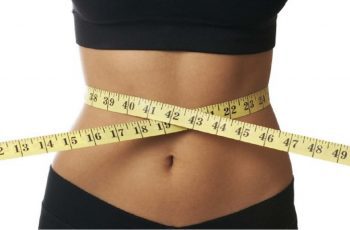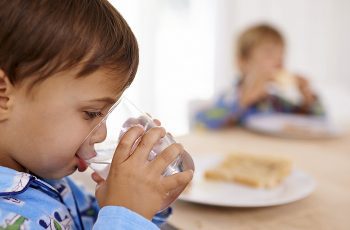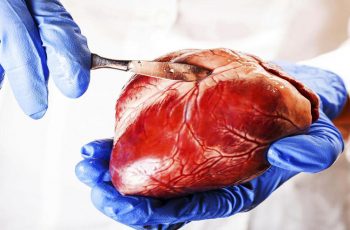Ensuring that your baby’s pacifiers are properly sterilized is crucial for maintaining their hygiene and safety. Pacifiers can harbor harmful bacteria, so it’s important to follow proper sterilization methods to keep your baby healthy.
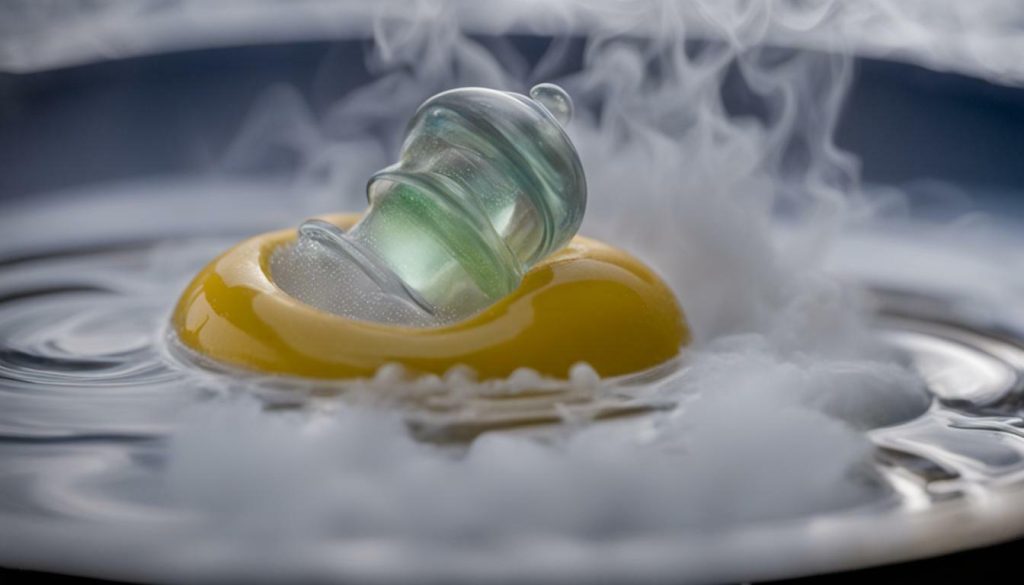
There are a few different methods you can use to sterilize pacifiers effectively. While methods like sticking the pacifier in your mouth or running it under water may seem convenient, they may not fully remove bacteria and potential pathogens.
One of the most effective ways to sterilize pacifiers is by boiling them in water. Simply place the pacifier in a pot of boiling water and let it simmer for about five minutes. After boiling, make sure to let it cool down completely before giving it to your baby.
Alternatively, there are sterilizer machines available that provide a convenient and thorough way to sterilize pacifiers. These machines use heat or steam to eliminate bacteria and germs, ensuring a clean and safe pacifier for your baby.
If you’re looking for a quick and easy option, microwave sterilizers are another great choice. These sterilizers utilize steam heat to kill bacteria in just a few minutes. Be sure to follow the manufacturer’s instructions carefully to ensure proper sterilization.
For those who prefer to use a dishwasher, you can also sterilize pacifiers by placing them in a separate container or bag and running them through a dishwasher cycle. This method is convenient and effective, especially if you already use a dishwasher for other baby items.
To further enhance the effectiveness of pacifier sterilization, it’s recommended to wash pacifiers with soap and hot water before sterilizing them. This will help remove any visible dirt or debris, allowing the sterilization process to be more effective.
Key Takeaways
- Properly sterilizing pacifiers is essential for maintaining your baby’s hygiene and safety.
- Boiling pacifiers in water for five minutes is an effective method, but they must cool down before use.
- Sterilizer machines, microwave sterilizers, and dishwasher sterilization are other convenient options.
- Washing pacifiers with soap and hot water prior to sterilization enhances effectiveness.
Why is Pacifier Sterilization Important?
Pacifier sterilization is essential due to the potential bacteria that can accumulate on these often-used baby items. Babies constantly suck on pacifiers, which introduces them to various germs and bacteria from their surroundings. Additionally, pacifiers can easily come into contact with dirt, saliva, and other contaminants, making them a breeding ground for harmful microorganisms. To ensure the health and safety of your baby, it is crucial to maintain proper pacifier hygiene by regularly cleaning and sterilizing them.
By sterilizing pacifiers, you can effectively eliminate bacteria and reduce the risk of your baby developing infections or illnesses. Bacteria such as streptococcus, staphylococcus, and yeast can thrive on pacifiers if they are not adequately cleaned. These microorganisms can cause oral thrush, respiratory infections, and other health issues in infants with developing immune systems.
To keep your baby’s pacifiers clean and safe, it is recommended to follow safe pacifier cleaning techniques. Simply rinsing pacifiers under water or using your mouth to clean them may not be sufficient in removing harmful bacteria. While these methods may provide temporary cleanliness, they do not guarantee thorough sterilization. Instead, opt for more effective methods like boiling pacifiers in water, using sterilizer machines, microwave sterilizers, or dishwasher sterilization.
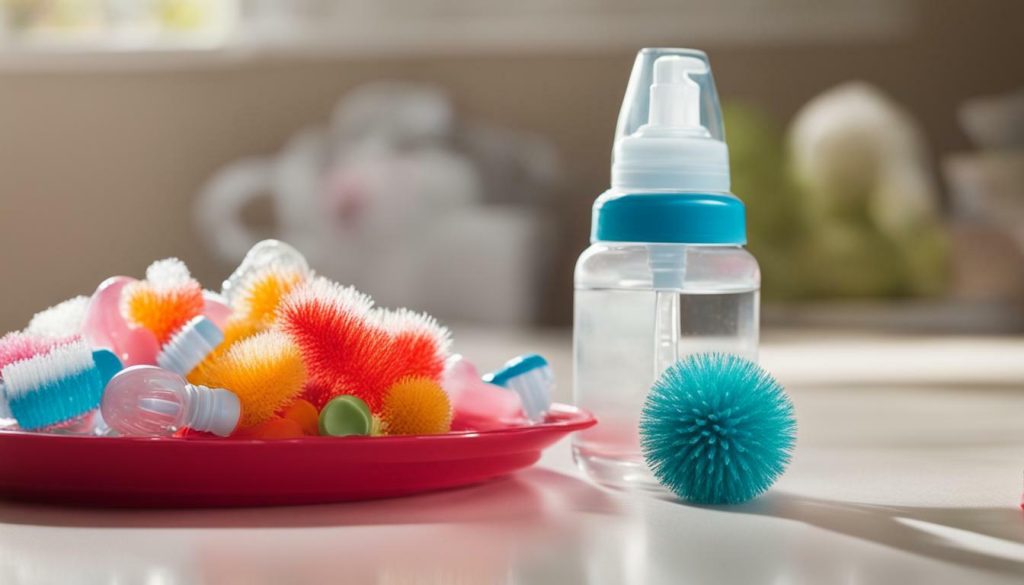
- Before sterilization, wash pacifiers with warm water and mild soap to remove dirt and debris.
- Boil pacifiers in water for at least five minutes to effectively kill bacteria. Allow them to cool down before giving them to your baby.
- Consider using sterilizer machines or microwave sterilizers for a convenient and efficient way to sterilize pacifiers.
- If using a dishwasher for sterilization, place pacifiers in a separate container or bag to prevent them from getting lost or damaged during the cleaning cycle.
- Regularly inspect pacifiers for signs of wear and tear, and replace them if necessary to avoid potential choking hazards.
- Avoid sharing pacifiers between babies to minimize the spread of germs and reduce the risk of cross-contamination.
By following these pacifier hygiene tips and regularly sterilizing your baby’s pacifiers, you can provide a clean and safe environment for your little one. Remember, maintaining proper pacifier hygiene is an essential part of promoting your baby’s overall health and well-being.
Washing Pacifiers with Soap and Water
Before sterilizing pacifiers, it is important to thoroughly wash them with soap and hot water to remove any dirt or debris. This step ensures that the pacifiers are clean before undergoing the sterilization process. Washing pacifiers with soap and water helps in eliminating any potential bacteria or germs that may be present on the surface.
To wash pacifiers with soap and water, start by using a mild dish soap and warm water. Gently scrub the pacifier with your hands, making sure to clean all sides and crevices. Pay special attention to the nipple and the handle, as these areas are often in contact with the baby’s mouth.
After washing, rinse the pacifiers thoroughly under running water to remove any soap residue. It is crucial to ensure that no soap remains on the pacifiers, as it can cause a bitter taste and discomfort for the baby.
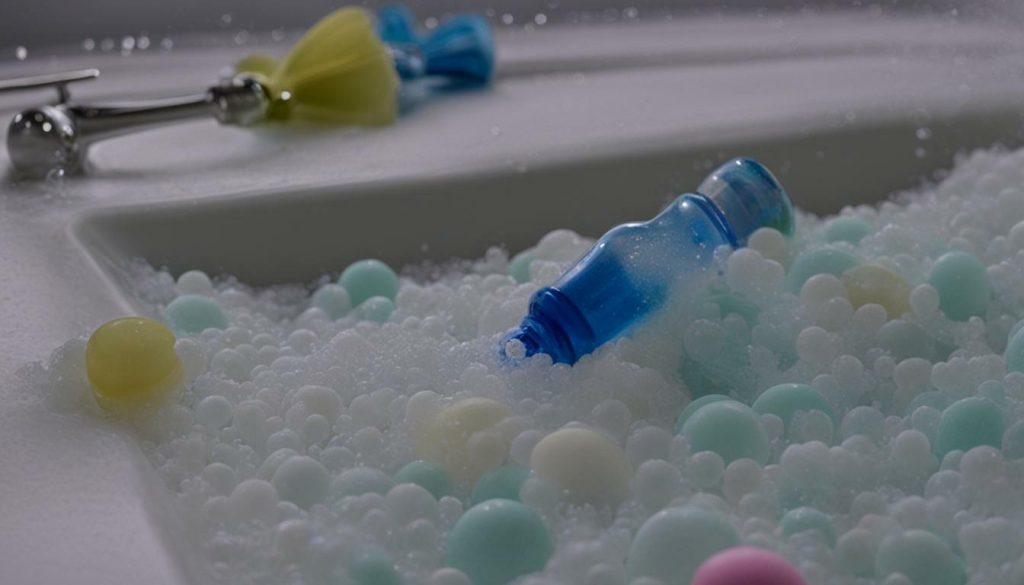
| Pros | Cons |
|---|---|
| Simple and cost-effective method | May not eliminate all bacteria |
| Gentle on pacifiers | Requires access to clean running water |
Washing pacifiers with soap and water is a convenient and accessible method for maintaining their cleanliness. However, it is important to note that this method may not completely sterilize the pacifiers. Therefore, it is recommended to follow up with a sterilization process, such as boiling or using a sterilizer machine, to ensure thorough sanitation.
Boiling Pacifiers in Water
Boiling pacifiers in water is a highly effective method for sterilization, ensuring the elimination of harmful bacteria. It is a simple and affordable way to keep your baby’s pacifiers clean and safe. All you need is a pot, water, and a few minutes of your time.
To begin the process, bring a pot of water to a rolling boil. Carefully place the pacifiers into the boiling water, making sure they are fully submerged. Let them boil for at least five minutes to ensure thorough sterilization. This process will kill any bacteria or germs that may be present, ensuring that the pacifiers are safe for your baby’s use.
After boiling, remove the pot from heat and allow the pacifiers to cool down completely before giving them to your baby. Use clean tongs to take them out of the pot and place them on a clean, dry surface. Avoid rushing this step, as hot pacifiers can cause burns or discomfort to your baby’s sensitive mouth.
| Pros of Boiling Pacifiers | Cons of Boiling Pacifiers |
|---|---|
| Highly effective in killing bacteria | Time-consuming process |
| Requires minimal equipment | Potential risk of burns if not handled properly |
| Affordable method | Pacifiers can wear out faster with frequent boiling |
Remember, boiling pacifiers in water should be done regularly to maintain proper hygiene. It is also important to wash pacifiers with soap and hot water before boiling them. This extra step helps remove any residue or dirt, ensuring a thorough sterilization process.
By following the simple steps of boiling pacifiers in water, you can provide your baby with clean and safe pacifiers, promoting their overall health and well-being.
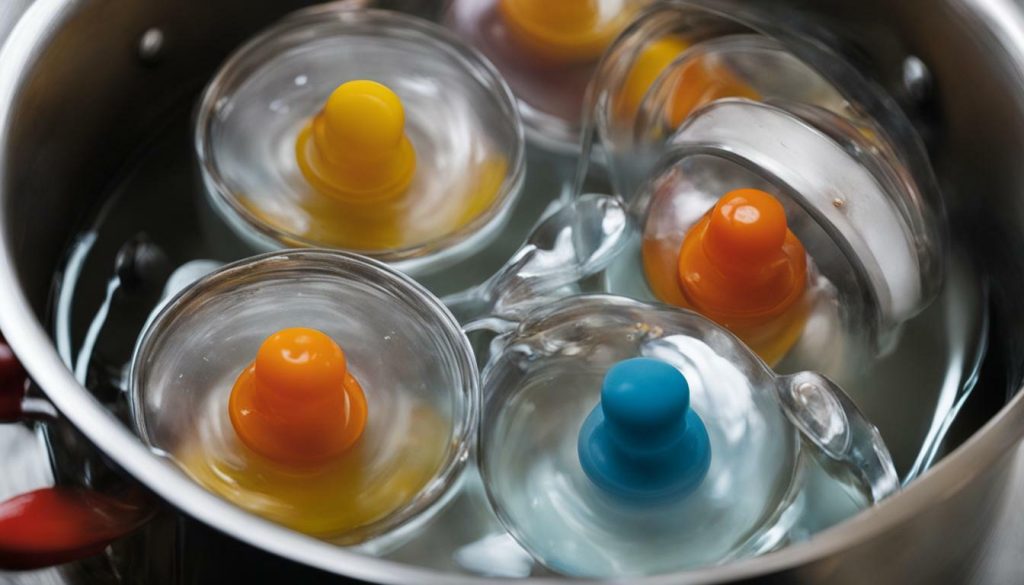
Sterilizer machines provide a convenient and efficient way to sterilize pacifiers at home, ensuring your baby’s safety. These machines are specifically designed to eliminate harmful bacteria and germs from pacifiers, giving you peace of mind. Simply place the pacifiers in the sterilizer, follow the manufacturer’s instructions, and let the machine do the rest.
One of the advantages of using sterilizer machines is that they offer a quick and easy solution. Most machines have preset sterilization cycles that only take a few minutes to complete. This means you can have sterilized pacifiers ready for your baby whenever you need them.
Additionally, sterilizer machines are designed to provide thorough disinfection. They use hot steam or ultraviolet light to kill bacteria, ensuring that your pacifiers are free from any harmful microorganisms. Some machines even have specialized compartments or trays to hold the pacifiers securely during the sterilization process.
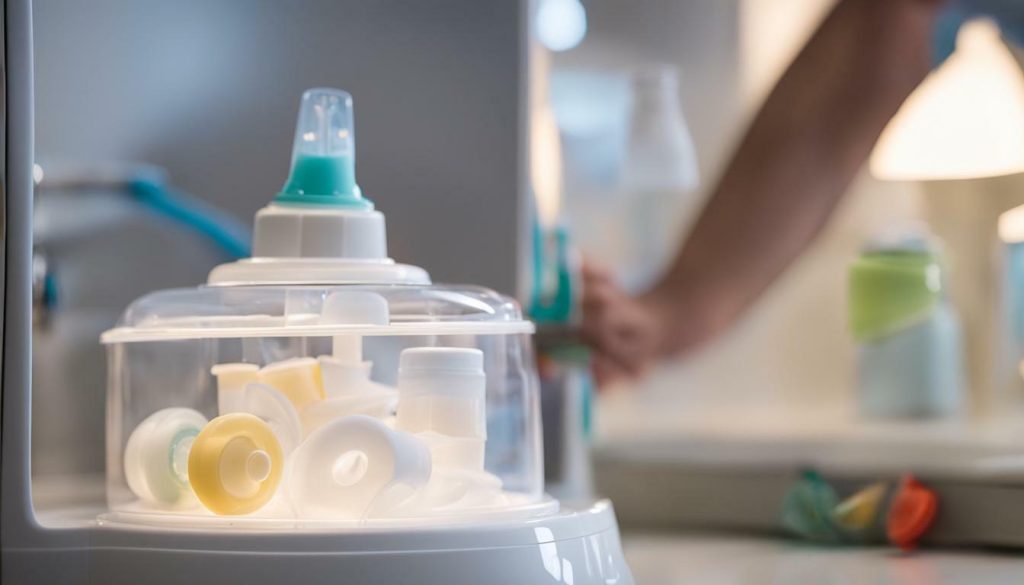
When using a sterilizer machine, it’s important to follow the manufacturer’s guidelines and maintain the machine’s cleanliness. Regularly clean and descale the machine as recommended to ensure its effectiveness. Remember to avoid overloading the machine, as this may hinder proper sterilization.
In conclusion, sterilizer machines provide a convenient and effective method for sterilizing pacifiers at home. By using these machines, you can ensure your baby’s pacifiers are free from harmful bacteria, providing them with a safe and hygienic experience. So, consider investing in a sterilizer machine to simplify your pacifier sterilization routine and prioritize your baby’s health.
Microwave Sterilizing Options
Microwave sterilizing options offer a quick and convenient way to sterilize pacifiers, saving you valuable time and effort. With this method, you can ensure that your baby’s pacifiers are free from harmful bacteria, providing them with a safe and hygienic experience.
To sterilize pacifiers in the microwave, start by placing them in a microwave-safe container. It’s important to use a container specifically designed for microwave sterilization to ensure safety. Add water to the container, covering the pacifiers completely. This allows steam to build up, effectively sterilizing the pacifiers.
Once the pacifiers are placed in the container with water, cover it securely and place it in the microwave. Follow the manufacturer’s instructions for the recommended microwave time. Typically, sterilizing pacifiers in the microwave takes less than five minutes. However, it’s important to note that exact timing may vary depending on the wattage of your microwave.
| Microwave Sterilizing Options | Pros | Cons |
|---|---|---|
| Quick and convenient | Save time and effort | Dependent on microwave wattage |
| Effective sterilization | Eliminates harmful bacteria | May require additional cooling time |
| Safe for baby | Ensures hygienic pacifiers | Requires a microwave-safe container |
After the pacifiers have been sterilized, it’s important to let them cool down before giving them to your baby. The microwave can heat up the container and the pacifiers themselves, so it’s crucial to ensure they are at a safe temperature for your baby’s delicate mouth.
Remember, microwave sterilizing options are just one of the many methods available for pacifier sterilization. It’s essential to follow the manufacturer’s instructions and take necessary precautions to ensure the safety and effectiveness of the sterilization process.
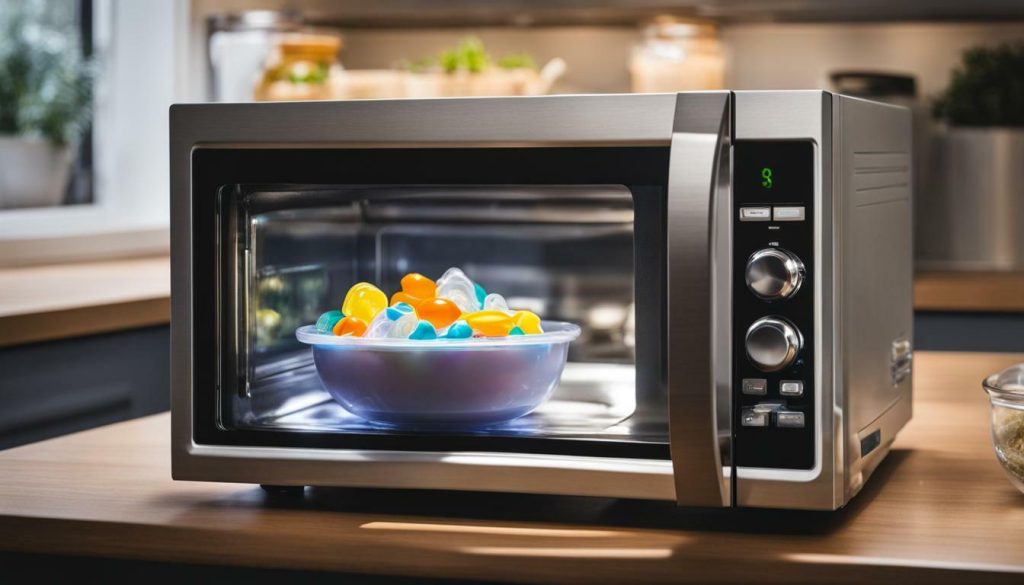
Dishwasher sterilization is a viable option for pacifier sterilization, as long as proper precautions are taken. With the use of hot water and high temperatures, dishwashers can effectively remove bacteria from pacifiers, ensuring a clean and safe item for your baby. However, it is important to note that not all pacifiers are dishwasher-safe, so be sure to check the manufacturer’s instructions before proceeding. It is also recommended to use a separate container or bag for holding the pacifiers during the dishwasher cycle to prevent them from getting lost or damaged.
To sterilize pacifiers in the dishwasher, start by removing any large pieces of food or debris from the pacifiers. Then, place them in a container or bag that is suitable for dishwasher use. Make sure to position them in a way that allows for proper water flow and thorough cleaning. It is advisable to avoid placing pacifiers directly on the dishwasher rack as it may lead to damage or contamination. Additionally, avoid mixing pacifiers with other items such as utensils or dishes to prevent cross-contamination.
Set your dishwasher to a hot water cycle with a high temperature and run the cycle as recommended by the manufacturer. It is important to note that dishwasher cycles may vary, so refer to the dishwasher’s instruction manual for specific guidelines. Once the cycle is complete, allow the pacifiers to cool down before giving them to your baby.
| Pacifier Sterilization Do’s | Pacifier Sterilization Don’ts |
|---|---|
|
|
Expert Tip:
“When using the dishwasher for pacifier sterilization, it is crucial to follow the manufacturer’s instructions. Some pacifiers may not be suitable for dishwasher use and may become damaged or less effective if exposed to high temperatures for extended periods.” – Dr. Emily Johnson, Pediatrician
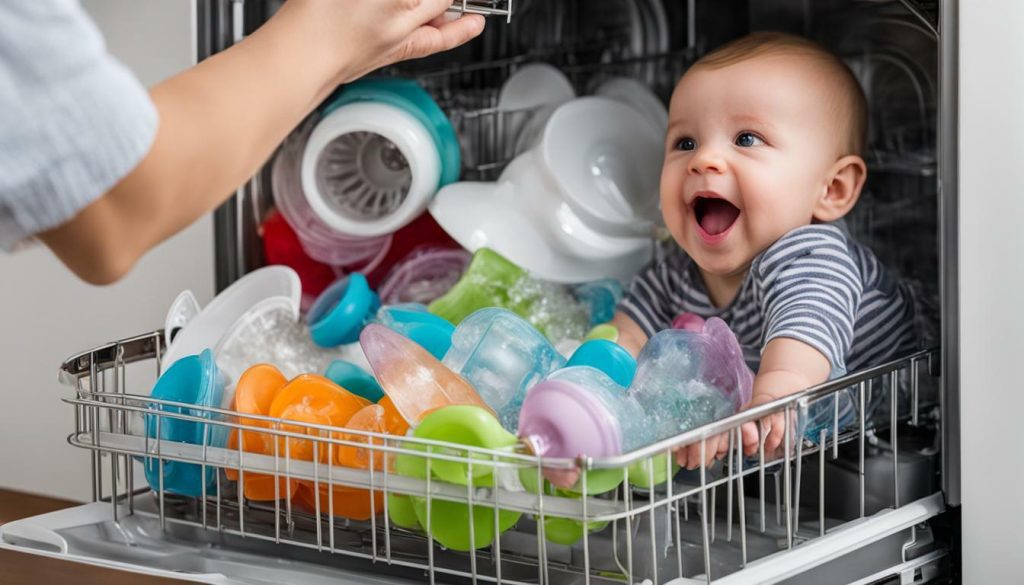
In addition to the sterilization methods mentioned earlier, there are a few other important considerations to keep in mind when it comes to pacifier hygiene and safety.
1. Avoid Sharing Pacifiers
While it may be tempting to share pacifiers between siblings or with friends’ babies, it’s crucial to avoid this practice. Sharing pacifiers can introduce harmful bacteria or viruses to your baby’s mouth, increasing the risk of infections. It’s best to stick to using individual pacifiers for each child and ensure they are properly sterilized before each use.
2. Regularly Inspect for Wear and Tear
Pacifiers can wear down over time and develop small cracks or tears, which can harbor bacteria. It’s important to regularly inspect your baby’s pacifiers for any signs of damage and replace them if necessary. Pay close attention to the nipple and the ring, ensuring they are intact and in good condition. By using pacifiers in good repair, you can minimize the risk of bacteria buildup and keep your baby safe.
3. Store Sterilized Pacifiers Properly
Once you’ve sterilized pacifiers, it’s essential to store them properly to maintain their cleanliness. Use a clean, dry container or a resealable bag to store sterilized pacifiers. Avoid storing them in places where they can come into contact with dirt or other contaminants. Additionally, make sure to wash your hands thoroughly before handling sterilized pacifiers to prevent the transfer of bacteria.
By following these additional considerations in addition to choosing an appropriate sterilization method, you can ensure your baby’s pacifiers are clean and safe for use. Remember, maintaining proper pacifier hygiene is crucial for your baby’s overall health and well-being.
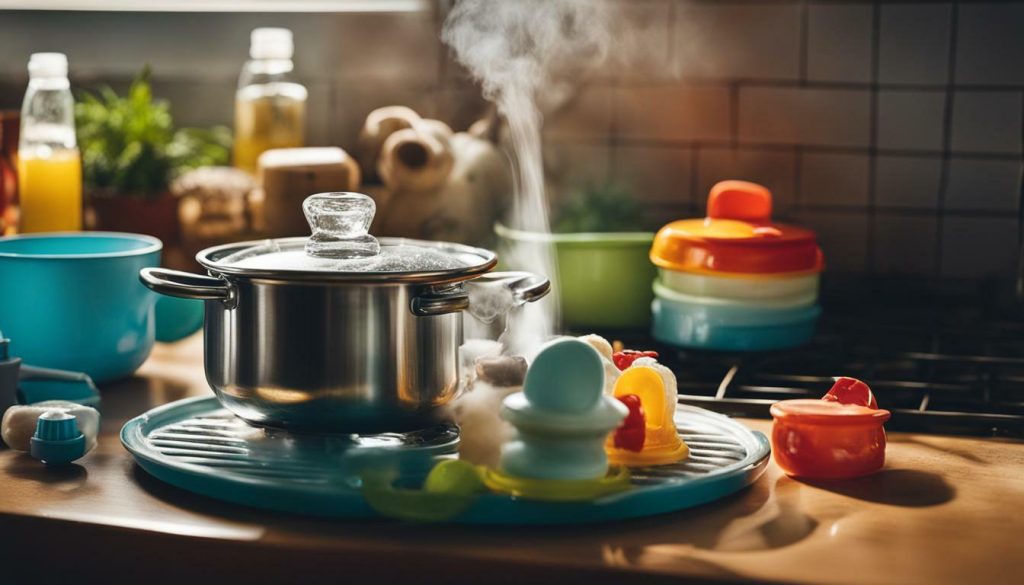
Proper pacifier sterilization is essential for your baby’s safety, and there are several effective methods available to ensure their hygiene and well-being.
While methods like sticking a pacifier in your mouth or running it under water may help remove visible dirt, they may not completely eliminate bacteria. It is important to remember that pacifiers can harbor harmful germs that can pose a risk to your baby’s health.
Boiling pacifiers in water for at least five minutes is one of the most effective methods of sterilization. However, it is crucial to allow the pacifiers to cool down before giving them to your baby to prevent any burns or injuries.
Alternatively, there are sterilizer machines, microwave sterilizers, and dishwasher sterilizing options available in the market. These methods provide convenience and ensure a thorough sterilization process for your baby’s pacifiers.
Before sterilizing, it is recommended to wash pacifiers with soap and hot water to remove any visible debris or residue. This step helps to enhance the effectiveness of the sterilization process.
Remember, maintaining a clean and safe pacifier is vital for your baby’s health. By following the appropriate sterilization methods, you can ensure your little one’s pacifiers are free from harmful bacteria, promoting their overall well-being.
FAQ
How often should I sterilize pacifiers?
It is recommended to sterilize pacifiers at least once a day, especially if they have been dropped or touched by anyone other than the baby.
Can I clean pacifiers by sticking them in my mouth or running them under water?
While these methods may remove some bacteria, they may not fully sterilize the pacifier. It is best to wash them with soap and hot water before sterilizing.
How long should I boil pacifiers in water for effective sterilization?
To effectively sterilize pacifiers, boil them in water for at least five minutes. Remember to allow them to cool down before giving them to your baby.
Are sterilizer machines a good option for pacifier sterilization?
Yes, sterilizer machines are an effective and convenient method for pacifier sterilization. They use steam to kill bacteria and can be used for various baby items.
Can I use a microwave for pacifier sterilization?
Yes, microwave sterilizing options are available for pacifiers. Follow the manufacturer’s instructions and ensure the pacifiers are placed in a microwave-safe container.
Can I sterilize pacifiers using a dishwasher?
Yes, you can use a dishwasher to sterilize pacifiers. However, it is important to place them in a separate container or bag to prevent contact with other items in the dishwasher.
How should I inspect pacifiers for wear and tear?
Regularly check pacifiers for any signs of damage, such as cracks or loose parts. Discard any pacifiers that show signs of wear or cannot be properly cleaned and sterilized.
Is it safe to share pacifiers between babies?
It is best to avoid sharing pacifiers between babies. Sharing can introduce bacteria from one baby to another, increasing the risk of infections.


